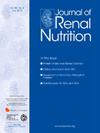英国不同肾病分期的饮食模式和每日食物摄入量比较:后验聚类分析。
IF 3.2
3区 医学
Q2 NUTRITION & DIETETICS
引用次数: 0
摘要
目的:膳食模式正迅速成为慢性肾脏病医学营养治疗的重点,膳食模式分析已成为评估整体膳食定性和定量方面的实用方法。在后验数据驱动法中,膳食模式是基于被评估人群的实际食物摄入量。对慢性肾脏病患者饮食模式的调查还没有很好的描述,而且据我们所知,还没有在英国的队列中进行过调查:方法:一项多中心横断面观察研究招募了已确诊肾病(CKD 1-5 不需要透析)的成人参与者。采用欧洲诺福克癌症前瞻性调查食物频率问卷对饮食摄入量进行评估。采用逻辑主成分分析法确定食物组群。采用单变量一般线性模型评估组间差异:共纳入 696 名患者。平均年龄为 64.7 (±14.0) 岁,61% 为男性。大多数参与者为英国白人(89%)。平均 eGFR 为 36.6 (±20.9) 毫升/分钟/1.732。我们发现不同阶段和不同性别人群的食物摄入量存在差异(例如,CKD 1-2 阶段与 CKD 4 阶段相比,坚果和种子的摄入量更高)(例如,女性与男性相比,水果和蔬菜的摄入量更高)。与参照队列进行比较后发现,总体而言,CKD队列的谷物和谷物制品等食物的摄入量有所减少,但肉类和肉制品等食物的摄入量较高。虽然维生素 B2 和钙的摄入量在早期阶段较高,但微量营养素方面的差异有限:总之,通过新颖的后验法得出的研究结果强调了慢性肾脏病患者饮食模式的复杂多样性。我们的研究结果可以让营养师和其他医疗服务提供者了解,在提供饮食建议时需要考虑治疗方式和阶段。本文章由计算机程序翻译,如有差异,请以英文原文为准。
Comparison of Dietary Patterns and Daily Food Intake Across Kidney Disease Stages in England: An A-Posteriori Cluster Analysis
Objective
Dietary patterns are rapidly becoming a major focus of medical nutrition therapy in chronic kidney disease (CKD) and the analysis of dietary patterns has emerged as a practical approach to evaluate qualitative as well as quantitative aspects of overall diet. In an a-posteriori data-driven approach, dietary patterns are based on the actual food intake of the population evaluated. Investigation of dietary patterns in CKD is not well-described, and to our knowledge, has not been conducted in a UK-based cohort.
Methods
Adult participants with a diagnosed kidney condition (CKD 1-5 not requiring dialysis) were recruited into a multicenter observational cross-sectional study. Dietary intake was assessed using the European Prospective Investigation of Cancer in Norfolk Food Frequency Questionnaire. Logistic Principal Component Analysis was used to identify food group clusters. Differences between groups were assessed using univariate general linear modeling.
Results
In total, 696 patients were included. The mean age was 64.7 (±14.0) years, 61% of the cohort were male. Most participants were White British (89%). The mean estimated glomerular filtration rate was 36.6 (±20.9) mL/minute/1.732. We found differences in food group intake across stages (e.g., greater intake of nuts and seeds intake in CKD 1-2 versus CKD 4) and across sex (e.g., females had a higher intake of fruit and vegetables versus males). Comparison with the reference cohort revealed that, overall, the CKD cohort had reduced intakes of food stuffs such as cereals and cereal products, but higher intakes of groups such as meat and meat products. There were limited differences in micronutrients, although vitamin B2 and calcium were higher in earlier stages.
Conclusion
Overall, the findings from a novel a-posteriori approach underline the complex diversity of food patterns in CKD. The findings from our study may inform dieticians and other health-care providers about the need to consider treatment modalities and stages when giving dietary recommendations.
求助全文
通过发布文献求助,成功后即可免费获取论文全文。
去求助
来源期刊

Journal of Renal Nutrition
医学-泌尿学与肾脏学
CiteScore
5.70
自引率
12.50%
发文量
146
审稿时长
6.7 weeks
期刊介绍:
The Journal of Renal Nutrition is devoted exclusively to renal nutrition science and renal dietetics. Its content is appropriate for nutritionists, physicians and researchers working in nephrology. Each issue contains a state-of-the-art review, original research, articles on the clinical management and education of patients, a current literature review, and nutritional analysis of food products that have clinical relevance.
 求助内容:
求助内容: 应助结果提醒方式:
应助结果提醒方式:


